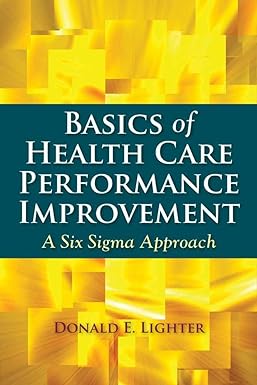Answered step by step
Verified Expert Solution
Question
1 Approved Answer
Trend projection, often represented by a trend line, involves fitting a line to the observed data points to represent the underlying trend. This line can
Trend projection, often represented by a trend line, involves fitting a line to the observed data points to represent the underlying trend. This line can be estimated using various regression techniques, such as ordinary least squares regression. Once the trend line is established, it can be extended into the future to forecast future values based on the trend's direction and slope.
Trend projection provides a straightforward representation of the trend but may not capture sudden changes or seasonal variations as effectively. Time series data exhibiting a trend requires forecasting techniques like trend projection to make accurate predictions that account for the underlying trend in the data.
You will often use software eg QM for Windows to find the trend equation. This equation is our tool for formulating forecasts by considering the trend. We follow this by applying a seasonal adjustment, multiplying the result by the respective seasonal index for each quarter.
Review the instructions from Render et al pp:
Excel QM: Select Alphabetical to see the techniques. Then select Forecasting and Regression Trend Analysis. When the input window opens, enter the number of past observations, and the spreadsheet is initialized, allowing you to input the Y values and the X values. Once you have established the trend line in QM you can input varying future dates to forecast when a given value will be reached.
QM for Windows: Select the Forecasting module, and then enter a new problem by selecting New Time Series Analysis. When the next window opens, enter the number of observations and press OK Enter the values Y for the past observations when the input window opens. It is not necessary to enter the values for X because QM for Windows will automatically use these numbers. Then click Solve.
Use the output to derive the data to find the solutions through simple calculations. For example, solving for x and then converting to a projected year.
Instructions:
Read the Case Study on JVB Electric Company in Chapter Use QM for Windows or Excel to answer the following questions:
Use regression to develop a trend line that could be used to forecast the number of changeovers per year for the next several years.
Explain the scatter plot, including a description of the trend.
Use the intercept and slope from your regression to forecast the year in which the number of changeovers will incur a cost greater than $ per year and thus make conjoining the three reservoirs a better option.
Describe whether the slope trend is negative or positive and what this indicates for sales.
Are the sales increasing or decreasing over time?
How do seasonal factors impact the slope?
If the extra maintenance cost for the single conjoined air reservoir was an additional $ per year instead of an additional $ per year, in what year would the number of changeovers make going to one reservoir a better option?
Report your findings, answering each question and subquestion. Including screenshots of your work in QM for WindowsExcel See POMQM Resources for assistance.
Step by Step Solution
There are 3 Steps involved in it
Step: 1

Get Instant Access to Expert-Tailored Solutions
See step-by-step solutions with expert insights and AI powered tools for academic success
Step: 2

Step: 3

Ace Your Homework with AI
Get the answers you need in no time with our AI-driven, step-by-step assistance
Get Started


